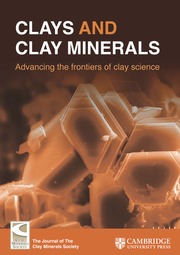Article contents
Sequestration of Catechol and Pentachlorophenol by Mechanochemically Treated Kaolinite
Published online by Cambridge University Press: 01 January 2024
Abstract
The pollution of soils by organic contaminants, such as phenols, is a serious problem because of the high toxicity and persistence in the environment. Mechanochemical treatments (MTs) of polluted soils with minerals, such as clays and oxides, which have surfaces that exhibit catalytic properties, have been suggested to be a new useful strategy to promote both organic and inorganic pollutant degradation. Nevertheless, much still remains to be studied about the capability of clays to promote pollutant removal by means of the mechanochemical activation of the mineral surfaces. This work investigates the efficiency of the mineral kaolinite in promoting the sequestration of catechol (CAT) and pentachlorophenol (PCP) by MT. A well crystallized kaolinite (KGa-1b) was milled for prolonged times with different amounts of organic molecules so as to obtain two different clay:organic compound ratios. Prolonged grinding and a higher clay mineral:organic compound ratio were found to be more effective in promoting a stronger removal than simple contact. After 1 h of mechanochemical treatment, the PCP and CAT removal percentages were 32% and 20%, respectively. Additionally, a 7-day undisturbed incubation of the milled mixtures produced a trend for increased CAT removal (up to 40%). The interaction mechanism between kaolinite and each organic compound (i.e. CAT and PCP) after a MT was inferred by integrating information from spectroscopic, diffractometric, and chromatographic analyses. X-ray diffraction and Fourier-transform infrared data suggested a strong interaction between CAT and KGa-1b. This interaction mechanism likely occurs through the formation of an inner-sphere complex by H-bonding between the organic molecules and the oxygens of the kaolinite tetrahedral sheet. On the other hand, a weak interaction (i.e. van der Waals type) can occur between the KGa-1b O-planes and the PCP molecules, which likely bind to the external surfaces of KGa-1b.
Information
- Type
- Article
- Information
- Copyright
- Copyright © Clay Minerals Society 2016
References
- 5
- Cited by

